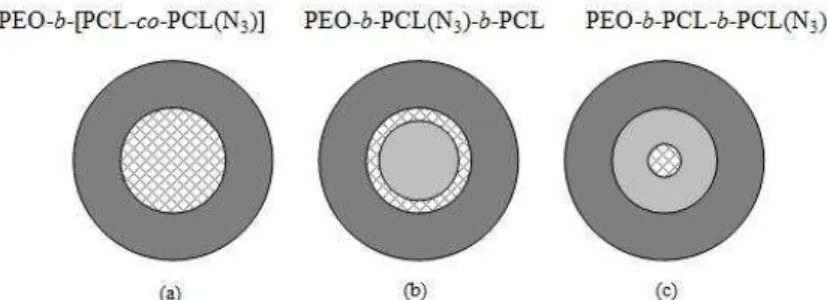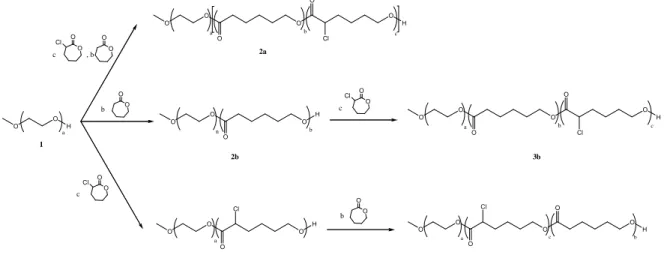Abstract for the Symposium on Innovative Polymers for Controlled Delivery
1 TAILOR-MADE COPOLYMERS FOR RESPONSIVE DRUG DELIVERY NANOSYSTEMS Sébastien Cajot1, Christine Jérôme1
1
Center for Education and Research on Macromolecules (CERM), University of Liege, B6 Sart tilman, B-4000 Liege, Belgium. e-mail: s.cajot@ulg.ac.be
Summary
Amphiphilic macromolecules combining a biodegradable and a bioeliminable block have been synthesized in order to build micellar drug delivery systems. Particularly, redox reversible disulfide linkages have been introduced in the structure to ensure cross-linking of the micelles formed in water and prevent their dissociation at high dilution upon injection. The synthesis of polymers and their micellization will be especially emphasized in this paper.
Key Words: biomaterials, polymer micelles, cross-linked micelles, glutathione responsive micelles. Introduction
Over the last decade, polymer micelles have attracted an increasing interest in pharmaceutical research because they could be used as efficient drug delivery systems [1]. Micelles of amphiphilic block copolymers are supramolecular core-shell type assemblies of tens of nanometers in diameter [2]. In principle, the micelle core is usually constructed with biodegradable hydrophobic polymers such as aliphatic polyesters, e.g. poly(ε-caprolactone) (PCL), which serves as a reservoir for the incorporation of various lipophilic drugs. Water soluble poly(ethylene oxide) (PEO) is most frequently used to build the micelle corona because it is very efficient in preventing protein adsorption at surfaces and in stabilizing the micelles in the blood compartment, giving rise to particles invisible to the body defence system [3].
Even if micelles get a high stability in aqueous media thanks to their low critical micellar concentration, the dissociation of micelles is not always preserved when they are injected in the blood compartment. The reversible cross-linking of the core of micelles by disulfide bridges has thus been targeted to provide the stability of micelles after the administration and release the drug by intracellular reduction of the disulfide bridges due to higher concentrations of gluthatione.
For this purpose, new functional macromolecular architectures have been synthesized and used to prepare micelles for the targeting of tumor cells. Basically, disulfide bridges have been introduced in the PCL segment by a well-known click-reaction of a bis-alkyne disulfide onto PCL bearing pendent azide groups. Three kinds of cross-linking strategies based on various block-copolymer architectures have been investigated depending on whether the core of the micelles is loosely cross-linked (a) or only the periphery (b) or the center (c) are fully cross-linked (Figure 1). The synthesis and the micellization of these macromolecular structures were studied and the efficiency of preventing dissociation around healthy cells was tested.
Abstract for the Symposium on Innovative Polymers for Controlled Delivery
2 Experimental Methods
Polymer Synthesis. MPEO-b-[PCL-co-PCL(Cl)] (2a) was prepared by ring-opening copolymerization
(ROP) of ε-caprolactone (ε-CL) and α-chloro-ε-caprolactone (α-Cl-ε-CL) using monomethoxy-poly(ethylene glycol) (MPEO) as macroinitiator. The polymerization was performed in toluene at reflux for 48 h in the presence of tin octoate. The same protocol was used for the synthesis of
MPEO-b-PCL-b-PCL(Cl) (3b), MPEO-b-PCL(Cl)-b-PCL (3c) by sequential polymerization. For polymer functionalization, chlorides were converted into azides by reaction of 2a, 3b and 3c with sodium azide (NaN3) in dimethylformamide (DMF) at room temperature overnight.
Formation of Micelles. A stock solution of copolymer (3a, 4b or 4c) was prepared with a well-defined
concentration (1%) in DMF in presence of the cross-linking agent (Scheme 3) which was synthesized according to a previous report [4]. A solution of 20 mL of water was added to the organic solution (5 mL) under vigorous stirring for one day. CuSO4 and sodium ascorbic acid were added to click the
cross-linking agent to the copolymer. The reaction was allowed to proceed for one day at room temperature and purified by dialysis against water.
Results and Discussion
The synthesis of the three macromolecular architectures, obtained by the ring-opening polymerization of ε-CL and α-Cl-ε-CL, is illustrated in Scheme 1. The control of the polymerization is confirmed by SEC with low polydispersity index and a shift of the elution time of the copolymer formed. Number-average molecular weights (Mn) and composition were determined by
1
H-NMR and are summarized in Table 1. Complete monomer conversion was obtained and the molar composition of the copolymers agreed with the composition of the comonomer feed.
O O H a O O O O Cl O O a O O O O H Cl b c O O n O O H b O O O O Cl O O a O O O O H Cl b c O O O O a O O O O H c b O O Cl O O O O H Cl b c a Cl c b c , b 1 2a 2b 2c 3b 3c
Scheme 1: Strategy for the synthesis of MPEO-b-[PCL-co-PCL(Cl)] (2a), MPEO-b-PCL-b-PCL(Cl) (3b), MPEO-b-PCL(Cl)-b-PCL (3c)
Table 1: Results obtained for the three copolymerizations of ε-CL and α-Cl-ε-CL from monomethoxy poly(ethylene glycol) Mn =5000 g/mol) by ROP.
Mn, thPCL (g/mol) (DP) Mn, thP(α-Cl-CL) (g/mol) (DP) DPth PCL / DPthP(α-Cl-CL) Mn, NMRPCL (g/mol) (DP) Mn, NMRP(α-Cl-CL) (g/mol) (DP) DPNMRP(α-Cl-CL) / DPNMR PCL Mw/Mn (SEC) 2a 1370 (12) 590 (4) 75/25 1480 (13) 590 (4) 76/24 1.08 3b 1370 (12) 590 (4) 75/25 1370 (12) 440 (3) 80/20 1.06 3c 1370 (12) 590 (4) 75/25 1370 (12) 740 (5) 70/30 1.05
The conversion of the chloride groups to azide by reaction with sodium azide to obtain the final macromolecular architecture is illustrated in Scheme 2. The IR spectrum shows a new absorption band at 2106 cm-1 characteristic of the azide. Quantitative conversion is confirmed by 1H-NMR with the disappearance of the CHCl peak at 4.25 ppm and the appearance of a new one at 3.85 ppm ( CHN3).
Abstract for the Symposium on Innovative Polymers for Controlled Delivery 3 OH O S S OH HO S O O 2
Scheme 2: Conversion of chloride to azide Scheme 3: Synthesis of the cross-linking agent
The micellization of these copolymers was studied by dissolving them in a good solvent of the hydrophilic and hydrophobic block and adding water. During this process, the cross-linking agent migrates to the hydrophobic core of micelles formed and, the addition of CuSO4 and sodium ascorbate
salt, cross-links the core of the micelles by the Huisgen 1,3-dipolar cycloaddition of azides present on the copolymers. Micelles obtained are characterized by dynamic light scattering (DLS) and transmission electron microscopy (TEM). The hydrodynamic diameter of the micelles formed under these conditions is reported in the Table 2. The spherical shape of the micelles was confirmed by TEM (Figure 2).
To confirm the cross-linking of the micelles, they were dissolved in DMF, a good solvent of the two blocks, and analyzed by DLS. Larger particles of about 200 nm are observed. In the case of non-cross-linked micelles, no signal was obtained. In addition, upon reaction with an excess of free thiol, the micelles formed in DMF lost their stability confirming the reversibility of the cross-linking.
Table 1: Size distribution obtained for micelles of copolymers 3a, 4b, 4c.
Figure 2: TEM micrographs of micelles of copolymer 4b Conclusion
Three new macromolecular architectures have been prepared for drug delivery systems. Micelles of these copolymers are nano-objects of about 40-50 nm. The cross-linking by disulfide bridges provided them the stability to be injected in the blood. In the future, cytotoxicity and cellular uptake of the micelles will be investigated further so as drug incorporation and release.
Acknowledgements
S.C. is grateful to the Belgian “Fond pour la Formation à la Recherche dans l’Industrie et dans l’Agriculture » (FRIA) for financial Support. The authors are much indebted to IAP VI-27 « Functional Supramolecular systems” (FS2).
References
[1] K. Kataoka, A. Harada, Y. Nagasaki, Block copolymer micelles for drug delivery: design, characterization and biological significance, Adv. Drug Deliv. Rev. 47(1) (2001) 113-131. [3] K. Van Butsele, R. Jérôme, C. Jérôme, Functional amphiphilic and biodegradable copolymers
for intravenous vectorization, Polymer 48(26) (2007) 7431-7443.
[4] C. Jérôme, P. Lecomte,Recent advances in the synthesis of aliphatic polyesters by ring-opening polymerization, Adv. Drug Deliv. Rev. 60(9) (2008) 1056-107.
[5] H. Gao, K.Matyjaszewski, Synthesis of star polymer by a combination of ATRP and the “click” coupling method, Macromolecules 39 (2006) 4960-4965.
Sample Dh (nm) PDI MPEO-b-[PCL-co-PCL(N3)] (3a) 49.9 0.17 MPEO-b-PCL-b-PCL(N3) (4b) 40.6 0.14 MPEO-b-PCL(N3)-b-PCL (4c) 53.8 0.2 MPEO-b-[PCL-co-PCL(N3)] 3a MPEO-b-PCL-b-PCL(N3) 4b MPEO-b-PCL(N3)-b-PCL 4c 2a, 3b, 3c NaN3 DMF, RT, 1 night


